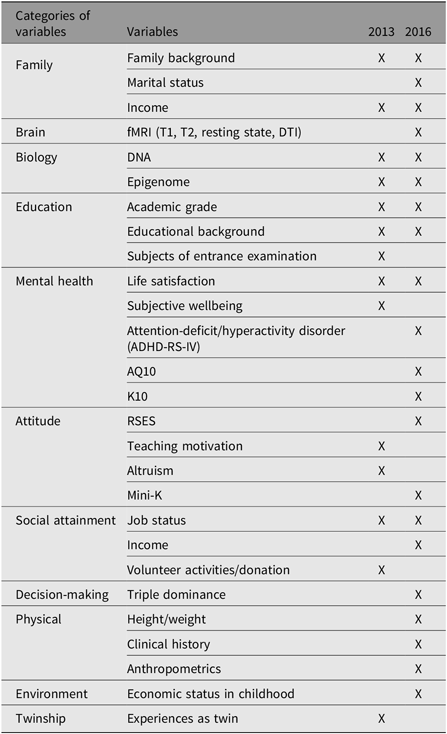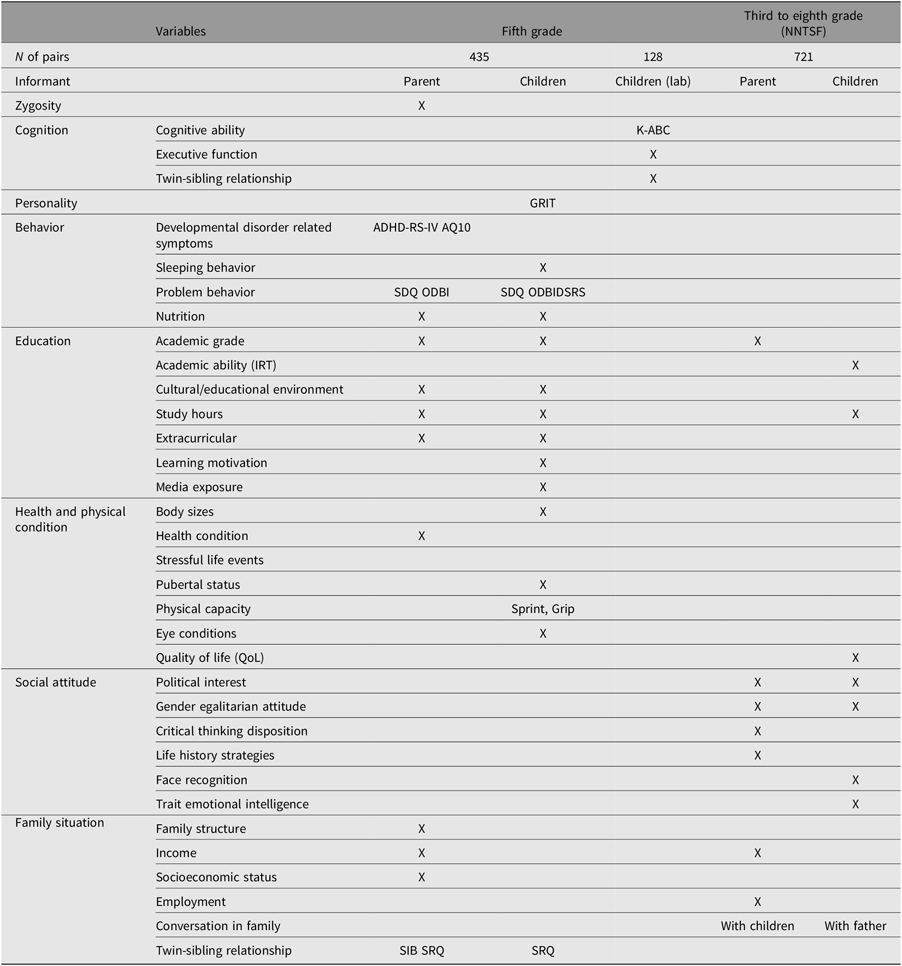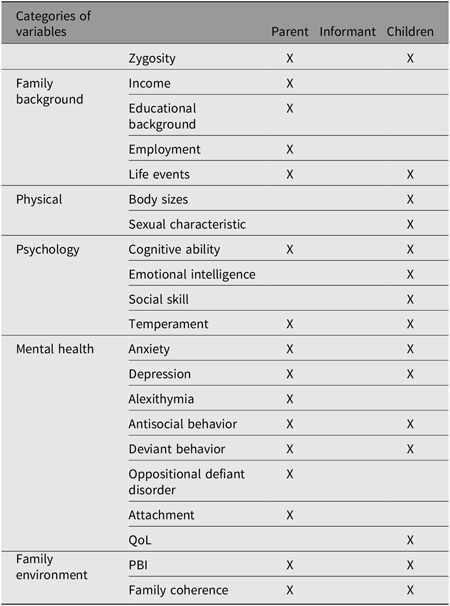The Keio Twin Research Center (KoTReC) is an integrated organization that conducts several longitudinal cohort projects and cross-sectional studies of twins. It was established in 2009 at Keio University to combine our two longitudinal cohort projects, the Keio Twin Study (KTS) for adolescence and adulthood and the Tokyo Twin Cohort Project (ToTCoP) for infancy and childhood. These two twin projects have been independently conducting various psychological, behavioral and socioeconomic studies over 20 years as the main databases of our center. The KTS conducts neurophysiological and molecular genetic studies, as well.
KoTReC also possesses three independent anonymous cross-sectional twin datasets. These cross-sectional datasets are not mentioned in this article except for their sample statistics in Table 1, because they were introduced in Ando et al. (Reference Ando, Fujisawa, Shikishima, Hiraishi, Nozaki, Yamagata and Ooki2013; see Table 1).
Table 1. Number of twin pairs in the independent databases in KoTReC

Note: Type — L = longitudinal; C = cross-sectional; KTS = Keio Twin Study; ToTCoP = Tokyo Twin Cohort Project; SPTA = a panel study of self-control and psychopathology in twin adolescence; fMZ = female monozygotic; mMZ = male monozygotic; fDZ = female dizygotic; mDZ = male dizygotic; oDZ = opporsite sex dizygotic.
The sources of funding for these studies include the Human Frontier Science Program, Grant-In-Aid of Scientific Research of the Ministry of Education, Culture, Sports, Science and Technology (MEXT) and the Japan Science and Technology Agency (JST). Ando et al. (Reference Ando, Nonaka, Ozaki, Sato, Fujisawa, Ozaki and Ooki2006, Reference Ando, Fujisawa, Shikishima, Hiraishi, Nozaki, Yamagata and Ooki2013) and Shikishima et al. (Reference Shikishima, Ando, Ono, Toda and Yoshimura2006) reported the basic research structure and findings of KoTReC. Afterwards, both the KTS and the ToTCoP conducted two additional surveys in 2013 and 2016 in the KTS and a survey for the fifth grade and a New Nuclear Twin Family Survey (NNTFS) of academic and socioemotional development in childhood and early adolescence in the ToTCoP on the educational and psychological attainments of child and young adolescent twins. Another independent survey, a panel study of self-control and psychopathology in twin adolescence (SPTA), which made two assessments over two successive years, was conducted in 2012 and 2013. The institutional review boards of the Faculty of Letters and Faculty of Economics, Keio University, approved all the surveys conducted at KoTReC.
Twin Recruitment
Recruitment of twins and twin families in the KoTReC studies was done by sending invitation letters to twin families in the Keio Twin Registry (KTR). The Basic Resident Register (BRR; a nationwide census) identified these twin families. The BRR is an official residential record of each municipal area containing each resident’s name, gender, residential address and date of birth. Each municipal area’s regulations authorize this information gathering, and data are available at each city hall. Twin birth sets and the other higher types of multiple birth sets can be identified as individuals who share the same date of birth and address. It is almost impossible to recruit newborn twins and adult twins living separately by this method because it takes several months for newborns to be registered on the BRR and because most adult twins live apart. These data are not obtained electronically but rather are obtained by printed documents at a substantial cost; therefore, well-trained staff were required to identify multiple births and to transfer the information manually. Although this strategy has a number of methodological shortcomings (see Ando et al., Reference Ando, Nonaka, Ozaki, Sato, Fujisawa, Ozaki and Ooki2006), it is the only way to obtain population-based rather than hospital-based or twin-organization-based twin data in Japan.
Residential twin data in the KTR include three collecting periods from the BRR (1998–2002, 2003–2004 and 2009) and cover Tokyo Metropolis and the neighboring prefectures (Kanagawa, Chiba and Saitama). The 1998–2002 data contain approximately 10,000 pairs, substantially overlapping with the 2003–2004 dataset containing 46,000 pairs. In addition, data from around 1000 pairs of twins under 3 years of age were added in 2009. Additional recruitment of twin child cohorts was conducted by voluntary participation through a poster campaign in public healthcare centers in the target areas and magazine advertisements in publications distributed nationwide. Currently, approximately 48,000 sets of multiple-birth families are registered in the KTR. However, a substantial portion of twin families in our registry have moved from their original places of residence and are untraceable now.
Zygosity Diagnosis and DNA Data
To identify twins’ zygosity, a self-reported three-item questionnaire (Ooki et al., Reference Ooki, Yamada, Asaka and Hayakawa1990) was used for adolescent and adult twins (the KTS and others), and a parent-reported six-item (three for each twin) questionnaire (Ooki & Asaka, Reference Ooki and Asaka2004) was used for infant and child twins (the ToTCoP and others). These questionnaires asked for judgments about the twins’ physical similarities, and experiences of being mistaken for each other, and have been found to have almost 95% accuracy as compared to the method using genetic markers (Ooki & Asaka, Reference Ooki and Asaka2004).
DNA samples were collected from adult twins only (in the KTS) by analyzing blood (approximately 240 pairs in 1998, partially replicated in 1999), buccal smear (approximately 200 pairs in 2005), nail or hair roots (approximately 100 pairs in 2010) and saliva (approximately 60 pairs in 2011). These DNA data were also used to identify zygosity. Currently, blood samples are being collected for an epigenetic study.
The numbers of sexes, zygosities and ages of twin pairs of subsamples in the KoTReC are shown in Table 1.
The Keio Twin Study
The KTS, known as the Keio Twin Project (KTP) before 2003 (Shikishima et al., Reference Shikishima, Ando, Ono, Toda and Yoshimura2006), was established in 1998 to conduct behavioral genetic studies in adolescence and early adulthood. Table 2 shows the variables of the updated surveys in 2013 and 2016. The timeline and variables of the project before 2012 were introduced in Ando et al. (Reference Ando, Fujisawa, Shikishima, Hiraishi, Nozaki, Yamagata and Ooki2013).
Table 2. Variables in the KTS surveys in 2013 and 2016

Note: ADHD-RS-IV = ADHD Rating Scale-IV (DuPaul et al., Reference Dupaul, Power, Anastopoulos and Reid1998); AQ10 = Autism Spectrum Quotient (Booth et al., Reference Booth, Murray, McKenzie, Kuenssberg, O’Donnell and Burnett2013); RSES = Rosenberg Self-Esteem Scale (Rosenberg, Reference Rosenberg1965); K10 (Kessler et al., Reference Kessler, Andrews, Colpe, Hiripi, Mroczek, Normand and Zaslavsky2002); Mini-K (Figueredo et al., Reference Figueredo, Vásquez, Brumbach, Schneider, Sefcek, Tal and Jacobs2006).
The main purpose of these surveys was to investigate genetic and environmental influences on the relationship between academic achievement and social attainment. The surveys in 2013 and 2016 included various aspects of educational variables (academic grades, educational background and subjects of university entrance examination) and the covariates of educational variables such as income, life satisfaction, subjective wellbeing and mental and physical health.
Behavioral neurogenetic variables (Time 1 and Time 2 images, resting state and diffusion tensor imaging by functional magnetic resonance imaging (fMRI) method and blood samples for epigenetic study) have been collected from monozygotic pairs to study their relationships with cognitive abilities and mental health. Anthropometric traits, including 3D imaging measurement of faces, have also been collected from twins to establish a genome montage technique.
Since the introductory paper in 2013 (Ando et al., Reference Ando, Fujisawa, Shikishima, Hiraishi, Nozaki, Yamagata and Ooki2013), two papers on decision-making (Hiraishi et al., Reference Hiraishi, Shikishima, Yamagata and Ando2015; Shikishima et al., Reference Shikishima, Hiraishi, Yamagata, Ando and Okada2015), two papers on laterality and motor activity (Suzuki & Ando, Reference Suzuki and Ando2015, Reference Suzuki and Ando2018) and one paper on self-esteem (Shikishima et al., Reference Shikishima, Hiraishi, Takahashi, Yamagata, Yamaguchi and Ando2018) have been published. Sasaki et al. (Reference Sasaki, Koken Ozaki, Yamagata, Takahashi, Shikishima, Kornacki and Ando2016) published a paper on gender identity disorder with over 4300 pairs of twins from the KTS database as well as the ToTCross database. Our data have contributed to two international collaborative papers on learning motivation (Kovas et al., Reference Kovas, Garon-Carrier, Boivin, Petrill, Plomin, Malykh and Vitaro2015) and personality (Mottus et al., Reference Mõttus, Sinick, Terracciano, Hřebíčková, Kandler, Ando and Jang2018).
The Tokyo Twin Cohort Project
The ToTCoP is a longitudinal cohort twin project for infants and children that started in 2003 (Ando et al., Reference Ando, Nonaka, Ozaki, Sato, Fujisawa, Ozaki and Ooki2006). Table 3 shows an outline of the questionnaire-based and laboratory-based research of the ToTCoP, which was conducted after 2013.
Table 3. Variables in ToTCoP

Note: ADHD-RS-IV = ADHD Rating Scale – IV (DuPaul et al., Reference Dupaul, Power, Anastopoulos and Reid1998); AQ10 = Autism Spectrum Quotient (Booth et al., Reference Booth, Murray, McKenzie, Kuenssberg, O’Donnell and Burnett2013); DSRS = Depression Self-Rating Scale for children (Birleson, Reference Birleson1981); GRIT (Duckworth et al., Reference Duckworth, Christopher Peterson, Matthews and Kelly2007); K-ABC = Kaufman Assessment Battery for Children (Kaufman & Kaufman, Reference Kaufman and Kaufman1983); ODBI = Oppositional Defiant Behavior Inventory (Harada et al., Reference Harada, Saitoh, Iida, Sakuma, Iwasaka, Imai and Amano2004); SDQ = Strength and Difficulty Questionnaire (Goodman, Reference Goodman1999); SIB = Sibling Inventory of Behavior (Volling & Blandon, Reference Volling, Blandon, Anderson Moore and Lippman2005); SRQ = Sibling Relationship Questionnaire (Furman & Buhrmester, Reference Furman and Buhrmester1985).
The first three columns in Table 3 show the variables in the survey for fifth graders, which is still collecting data from 11-year-old children. The rightmost two columns in Table 3 show the variables of the NNTFS, conducted in 2017, forthird through eighth graders. Because our twin participants are at an age at which they can answer questionnaire items themselves, the responses of both parents and twin children were provided.
Academic and psychological adaptation to the elementary school situation was the target of the fifth questionnaire survey. This questionnaire contains self-reported education-related variables (academic grade, study hours, cultural/educational environment, extracurricular, learning motivation and media exposure) and variables related to psychological maladaptation (attention deficit hyperactivity disorder, autistic tendency and conduct problems). The laboratory-based survey focuses on cognitive abilities (the Kaufman Assessment Battery for Children, K-ABC) and executive functions (inhibition, switching and updating) as well as the social relationship between twin siblings.
There is a new publication by the ToTCoP on developmental changes between 42 and 60 months due to genetic and environmental influences on cognitive ability, executive function and preacademic skills (Fujisawa et al., Reference Fujisawa, Todo and Ando2019).
The NNTFS was a cross-sectional survey in a longitudinal cohort sample of the ToTCoP conducted in 2017–2018. It covered twins from the third to the eighth grade and their parents. A set of information letters regarding their participation in the NNTFS survey was delivered to twin families in December 2017. A total of 1601 families received the invitation letters by post. Of the 1601 families, 750 families returned their application form to participate in this survey, showing a response rate of 46.8%. After their agreement to participate in this survey, the eligible families received a set of four self-administered questionnaires (co-twins, mothers and fathers) in February 2018. A total of 722 families (96.3%) gave their full informed consent in writing to participate in this survey and completed the questionnaires. The institutional review boards of Teikyo University and The University of Tokyo as well as the Faculty of Letters and Faculty of Economics, Keio University, approved the NNTFS.
The main focus of the NNFTS was academic and socioemotional development in children and young adolescents. In this questionnaire, performance tests originally developed by item response theory (IRT) were used to measure children’s own academic abilities. The questionnaire was also used to measure political, social and economic variables such as income, employment, political interest, gender egalitarian attitude, critical thinking disposition and life history strategies.
A Panel Study of Self-Control and Psychopathology in Twin Adolescence
From the KTR, other twin-family participants who were not overlapping with the participants of the KTS and the ToTCoP were sampled. This new research was a two-time panel study of SPTA that covered twins from the fourth to the tenth grade. A total of 968 twin families participated the first time and 905 families participated the second time, among which 381 families overlapped and provided longitudinal data.
The SPTA is a questionnaire-based study, and its variables are listed in Table 4. The same structure of variables was replicated in the successive two time points. As this table shows, both parents and twin children were informants. Common psychological variables such as self-reported and parent-reported cognitive and emotional intelligence, temperament, social skills and mental health variables such as anxiety, depression, alexithymia, antisocial behavior and deviant behavior were measured.
Table 4. Variables in the SPTA

Note: PBI = Parental Bonding Instrument (Parker et al., Reference Parker, Tupling and Brown1979).
Future Perspectives
Most parts of the KoTReC surveys are still ongoing and are still being analyzed; therefore, papers based on these surveys will only be published in the future.
Our research center has several shortcomings. Many aspects of the database are incomplete. We have not yet established complete DNA samples from all the twin participants in our project because of budget limitations, which have also led to difficulties in long-term planning and administration of well-organized research. It is very difficult to recruit twins into research programs because we do not have free access to official electronic databases of Japanese residents for scientific use. Another serious problem is data attrition.
KoTReC has the largest twin sample in Japan with more than 10,000 twin pairs from infancy to adulthood; half of the twin pairs (approximately 5000 pairs) are longitudinal, and data collection, including neurogenomic data, is ongoing. Most of the measurement tools are of international standards. There are many possibilities for conducting and developing scientifically significant twin research at KoTReC.
Acknowledgments
The studies of the Keio Twin Research Center were supported by Grant-in-Aid for Scientific Research, Human Frontier Science Program, Brain Science and Education Program of RISTEX-JST and Keio University. We also thank our technical assistants and the twin families who contributed to our research activities.








